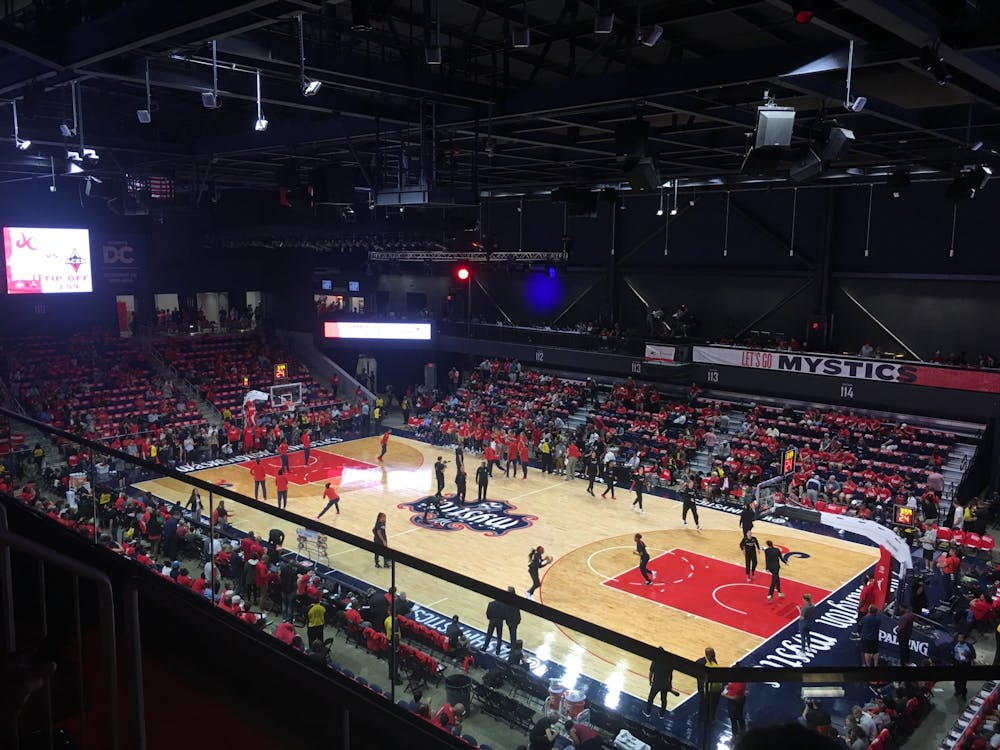Not many Washington Mystics fans would have predicted that, halfway through their title-defending season, the Mystics would sit at just 4-7.
After winning their first three games, the Mystics dropped seven straight, falling to the 10th seed in the league with 12 games to go. A dropoff was not out of the question, especially with Elena Delle Donne, Washington’s superstar and arguably the best player in the league, sitting out due to her battle with Lyme disease. Swiftly following Delle Donne’s decision, all-star offseason addition Tina Charles and Natasha Cloud announced they would sit-out due to health concerns and to fight for social justice reforms, respectively. Add those absences together, and it's not surprising to see the reigning champions free fall like this.
But what happened between those first three outstanding performances and the lackluster next seven? Even without Delle Donne and Charles, the Mystics looked like a solid, competitive team through three games — or certainly one that would reach the playoffs.
The Mystics’ main issue is their inability to put the ball in the basket. After being the highest-scoring and most-efficient offensive team in the league last year, the former offensive juggernauts have plummeted without Delle Donne, becoming the third-worst offense in the league, and averaging the fourth-fewest points per game.
Washington attempts the third-most 3-pointers in the league, but convert their attempts at the fourth-worst percentage in the league. Only four of their 11 players, who have played at least six games, are shooting better than 34 percent from three, which is roughly considered to be a league-average clip.
Without Delle Donne and Charles, the Mystics have had to rely on Aerial Powers and Myisha Hines-Allen to be their leading scorers. But that pair has been a mixed bag. Powers is currently out indefinitely with a hamstring injury, and Hines-Allen has cooled off after a great first five games.
Hines-Allen was thrown into a starring role this season after averaging just 3.1 points per game in her first two years in the league. While she has clearly made vast improvements in her game, she doesn’t look ready to take on such a prominent offensive role at this point in her career.
On the bright side, guard Ariel Atkins seems to be finding her scoring touch over the last two games after failing to reach double-digits in the previous four. Feeding the hot-hand is the easiest way for a team struggling offensively to pull themselves out of a hole.
Another way for the team to find better scoring opportunities is by getting out in transition. The Mystics have been solid defensively throughout the first half of the season, and they are second in the league in defensive rebounding percentage. But they are only eighth (out of 12 teams) in overall pace of play. If they take advantage of those rebounding opportunities and play at a faster pace, they should be able to manufacture more layups and open jumpers. Overall aggressiveness seems to be the key to unlocking some type of offensive success.
“We’re tired of getting popped in the mouth first when we come into these games,” Mystics center Alaina Coates told the Washington Post. “We want to pop somebody first. We’re working on this mentality of just being more aggressive. Kind of having a bit more of a grittiness about ourselves.”
That aggressiveness showed up on Thursday when the Mystics snapped their seven-game skid by beating the Atlanta Dream, with rookie guard Stella Johnson, who, in her first career start, scored a career-high 25 points and hit six 3-pointers, a team-rookie record. The entire starting lineup scored in double digits, with Hines-Allen putting up 23 as well.
But at the end of the day, without Delle Donne and Charles, this iteration of Mystics just doesn’t have the talent needed to return to their championship contending ways. Maybe if the shots start falling they can get back in the playoffs. But not much should be expected if they get there.





